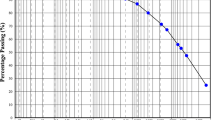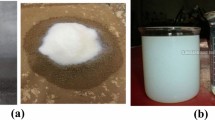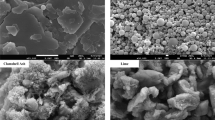Abstract
This study aims to assess the suitability of micro-silica (MS) as an industrial waste to modify the hydro-mechanical behavior of expansive soil in comparison with the use of lime as a traditional stabilizer. Due to limitations associated with soil treatment with calcium-based materials, the effect of lime–micro-silica (LMS) on stabilization of expansive clay was also studied with the aim of reducing the amount of lime consumption. The clay was stabilized with different percentages of lime alone (3% and 5%), MS alone (10% and 20%) and mixtures of LMS (3–10%, 5–10%, 3–20% and 5–20%). Experimental study performed on treated and untreated specimens included the reactivity tests measuring the pozzolanicity of the additives, compaction characteristics and Atterberg limits of mixtures, one-dimensional swell, compressibility, shrinkage, unconfined compressive strength of compacted specimens of different mixtures, as well as X-ray diffraction, scanning electron microscopy and wet chemistry analysis to study the mineralogy, microstructure and chemical composition of specimens. The results showed that the addition of MS alone did not have a significant effect on the stabilization of expansive soil, whereas stabilization with LMS achieved promising results with 10% MS + 3% lime mixture, hence achieving the goals of recycling MS as well as minimizing the amount of lime used. This combination was effective in improving the hydro-mechanical behavior of the clay due to formation of cementitious compounds resulting from pozzolanic reactions between Ca2+ of lime and SiO2 of micro-silica.













Similar content being viewed by others
References
Abdi MR, Askarian A, Gonbad MSS (2019) Effects of sodium and calcium sulphates on volume stability and strength of lime-stabilized kaolinite. Bull Eng Geol Environ 79:1–17. https://doi.org/10.1007/s10064-019-01592-1
Abdi MR, Chehregosha A, Farzalizadeh R (2019) Effects of miscellaneous plasticity on behavior of lime-treated kaolinites. Int J Geotech Eng. https://doi.org/10.1080/19386362.2019.1677401
Abo-El-Enein SA, Heikal M, Amin MS, Negm HH (2013) Reactivity of dealuminated kaolin and burnt kaolin using cement kiln dust or hydrated lime as activators. Constr Build Mater 47:1451–1460. https://doi.org/10.1016/j.conbuildmat.2013.06.078
Akbulut S, Saglamer A (2004) Modification of hydraulic conductivity in granular soils using waste materials. Waste Manag 24(5):491–499. https://doi.org/10.1016/j.wasman.2004.01.002
Al-Mukhtar M, Lasledj A, Alcover JF (2010) Behaviour and mineralogy changes in lime-treated expansive soil at 20 °C. Appl Clay Sci 50(2):191–198. https://doi.org/10.1016/j.clay.2010.07.023
Alrubaye AJ, Hasan M, Fattah MY (2017) Stabilization of soft kaolin clay with silica fume and lime. Int J Geotech Eng 11(1):90–96. https://doi.org/10.1080/19386362.2016.1187884
Alrubaye AJ, Hasan M, Fattah MY (2018) Effects of using silica fume and lime in the treatment of kaolin soft clay. Geomech Eng 14(3):247–255. https://doi.org/10.12989/gae.2018.14.3.247
AL-Soudany KY (2018) Improvement of expansive soil by using silica fume. Kufa J Eng 9(1):222–239. https://doi.org/10.30572/2018/kje/090115%20%20%20%20
Amin MS, Hashem FS (2011) Hydration characteristics of hydrothermal treated cement kiln dust–sludge–silica fume pastes. Constr Build Mater 25(4):1870–1876. https://doi.org/10.1016/j.conbuildmat.2010.11.073
Asl FN, Asgari HR, Emami H, Jafari M (2019) Combined effect of micro silica with clay, and gypsum as mulches on shear strength and wind erosion rate of sands. Int Soil Water Conserv Res 7(4):388–394. https://doi.org/10.1016/j.iswcr.2019.03.003
ASTM C1240-15 (2015) Standard specification for silica fume used in cementitious mixtures. ASTM International, West Conshohocken. https://doi.org/10.1520/C1240-15
ASTM C593-06 (2011) Standard specification for fly ash and other pozzolans for use with lime for soil stabilization. ASTM International, West Conshohocken. https://doi.org/10.1520/C0593-06R11
ASTM C618-19 (2019) Standard specification for coal fly ash and raw or calcined natural pozzolan for use in concrete. ASTM International, West Conshohocken. https://doi.org/10.1520/C0618-19
ASTM D2166/D2166M-16 (2016) Standard test method for unconfined compressive strength of cohesive soil. ASTM International, West Conshohocken. https://doi.org/10.1520/D2166_D2166M-16
ASTM D2435/D2435M-11 (2011) Standard test methods for one-dimensional consolidation properties of soils using incremental loading. ASTM International, West Conshohocken. https://doi.org/10.1520/D2435_D2435M-11
ASTM D2487-17 (2017) Standard practice for classification of soils for engineering purposes (unified soil classification system). ASTM International, West Conshohocken. https://doi.org/10.1520/D2487-17
ASTM D4318-17e1 (2017) Standard test methods for liquid limit, plastic limit, and plasticity index of soils. ASTM International, West Conshohocken. https://doi.org/10.1520/D4318-17E01
ASTM D4546-14e1 (2014) Standard test methods for one-dimensional swell or collapse of soils. ASTM International, West Conshohocken. https://doi.org/10.1520/D4546-14E01
ASTM D698-12e2 (2012) Standard test methods for laboratory compaction characteristics of soil using standard effort (12,400 ft-lbf/ft3 (600 kNm/m3)). ASTM International, West Conshohocken. https://doi.org/10.1520/D0698-12E02
ASTM D854-14 (2014) Standard test methods for specific gravity of soil solids by water pycnometer. ASTM International, West Conshohocken. https://doi.org/10.1520/D0854-14
Barbhuiya SA, Gbagbo JK, Russell MI, Basheer PAM (2009) Properties of fly ash concrete modified with hydrated lime and silica fume. Constr Build Mater 23(10):3233–3239. https://doi.org/10.1016/j.conbuildmat.2009.06.001
Bharadwaj S, Trivedi MK (2016) Impact of micro silica fume on engineering properties of expansive soil. Int J Sci Technol Eng 2:435–440
Bell FG (1996) Lime stabilization of clay minerals and soils. Eng Geol 42(4):223–237. https://doi.org/10.1016/0013-7952(96)00028-2
Borsadiya AK (2018) Improvement of compressive strength of clayey soil with microsilica (Doctoral dissertation, Texas A&M University-Kingsville)
Bozbey I, Garaisayev S (2010) Effects of soil pulverization quality on lime stabilization of an expansive clay. Environ Earth Sci 60(6):1137–1151. https://doi.org/10.1007/s12665-009-0256-5
Buttress AJ, Grenfell JA, Airey GD (2015) Accelerated swell testing of artificial sulfate bearing lime stabilised cohesive soils. Mater Struct 48(11):3635–3655. https://doi.org/10.1617/s11527-014-0428-y
Chen R, Ding X, Ramey D, Lee I, Zhang L (2016) Experimental and numerical investigation into surface strength of mine tailings after biopolymer stabilization. Acta Geotech 11(5):1075–1085. https://doi.org/10.1007/s11440-015-0420-x
Cristelo N, Glendinning S, Fernandes L, Pinto AT (2013) Effects of alkaline-activated fly ash and Portland cement on soft soil stabilisation. Acta Geotech 8(4):395–405. https://doi.org/10.1007/s11440-012-0200-9
Dash SK, Hussain M (2015) Influence of lime on shrinkage behavior of soils. J Mater Civ Eng 27(12):04015041. https://doi.org/10.1061/(ASCE)MT.1943-5533.0001301
Dotto JMR, De Abreu AG, Dal Molin DCC, Müller IL (2004) Influence of silica fume addition on concretes physical properties and on corrosion behaviour of reinforcement bars. Cem Concr Compos 26(1):31–39. https://doi.org/10.1016/S0958-9465(02)00120-8
Eberemu AO (2013) Evaluation of bagasse ash treated lateritic soil as a potential barrier material in waste containment application. Acta Geotech 8(4):407–421. https://doi.org/10.1007/s11440-012-0204-5
Fasihnikoutalab MH, Pourakbar S, Ball RJ, Unluer C, Cristelo N (2019) Sustainable soil stabilisation with ground granulated blast-furnace slag activated by olivine and sodium hydroxide. Acta Geotech 15:1–11. https://doi.org/10.1007/s11440-019-00884-w
Fattah MY, Al-Saidi AA, Jaber MM (2015) Improvement of bearing capacity of footing on soft clay grouted with lime–silica fume mix. Geomech Eng 8(1):113–132. https://doi.org/10.12989/gae.2015.8.1.000
Firoozi AA, Olgun CG, Firoozi AA, Baghini MS (2017) Fundamentals of soil stabilization. Int J Geo-Eng 8(1):26. https://doi.org/10.1186/s40703-017-0064-9
Fredlund MD, Wilson GW, Fredlund DG (2002) Representation and estimation of the shrinkage curve. In: Proceedings of 3rd international conference on unsaturated soils, UNSAT 2002, pp 145–149. Retrieved July 19, 2019, from http://hdl.handle.net/1783.1/13621
Gadouri H, Harichane K, Ghrici M (2017) Effect of calcium sulphate on the geotechnical properties of stabilized clayey soils. Period Polytech Civ Eng 61(2):256–271. https://doi.org/10.3311/PPci.9359
Ghorbani A, Hasanzadehshooiili H, Karimi M, Daghigh Y, Medzvieckas J (2015) Stabilization of problematic silty sands using microsilica and lime. Baltic J Road Bridge Eng 10(1):61–70. https://doi.org/10.3846/bjrbe.2015.08
Giridharan A, Bharathan R, Saranya P (2017) Soil stabilization using silica fume and cement. SSRG Int J Civ Eng 17(1):78–82
Golhashem MR, Uygar E (2019) Improvement of internal stability of alluvial clay from Famagusta Bay, Cyprus, using copolymer of butyl acrylate and styrene. Environ Eng Geosci 25:1–12. https://doi.org/10.2113/EEG-2205
Golhashem MR, Uygar E (2020) Volume change and compressive strength of an alluvial soil stabilized with butyl acrylate and styrene. Constr Build Mater 255:119352. https://doi.org/10.1016/j.conbuildmat.2020.119352
Goodarzi AR, Goodarzi SH, Akbari HR (2015) Assessing geo-mechanical and micro-structural performance of modified expansive clayey soil by silica fume as industrial waste. Iran J Sci Technol Trans Civ Eng 39(C2):333–350. https://doi.org/10.22099/ijstc.2015.3138
James J, Pandian PK (2016) Industrial wastes as auxiliary additives to cement/lime stabilization of soils. Adv Civ Eng. https://doi.org/10.1155/2016/1267391
Kalkan E (2009) Influence of silica fume on the desiccation cracks of compacted clayey soils. Appl Clay Sci 43(3–4):296–302. https://doi.org/10.1016/j.clay.2008.09.002
Kalkan E (2011) Impact of wetting–drying cycles on swelling behavior of clayey soils modified by silica fume. Appl Clay Sci 52(4):345–352. https://doi.org/10.1016/j.clay.2011.03.014
Kalkan E, Akbulut S (2004) The positive effects of silica fume on the permeability, swelling pressure and compressive strength of natural clay liners. Eng Geol 73(1–2):145–156. https://doi.org/10.1016/j.enggeo.2004.01.001
Koteng DO, Chen CT (2015) Strength development of lime–pozzolana pastes with silica fume and fly ash. Constr Build Mater 84:294–300. https://doi.org/10.1016/j.conbuildmat.2015.03.052
Latifi N, Marto A, Eisazadeh A (2016) Physicochemical behavior of tropical laterite soil stabilized with non-traditional additive. Acta Geotech 11(2):433–443. https://doi.org/10.1007/s11440-015-0370-3
Little DN, Nair S (2009) Recommended practice for stabilization for sulfate rich subgrade soils. National Highway Cooperative Research Program, Transportation Research Board of the National Academies, Washington, DC. https://doi.org/10.17226/22997
Luxán MD, Madruga F, Saavedra J (1989) Rapid evaluation of pozzolanic activity of natural products by conductivity measurement. Cem Concr Res 19(1):63–68. https://doi.org/10.1016/0008-8846(89)90066-5
Malekzadeh M, Bilsel H (2014) Use of posidonia oceanica ash in stabilization of expansive soils. Mar Georesour Geotechnol 32(2):179–186. https://doi.org/10.1080/1064119X.2012.728685
Maubec N, Deneele D, Ouvrard G (2017) Influence of the clay type on the strength evolution of lime treated material. Appl Clay Sci 137:107–114. https://doi.org/10.1016/j.clay.2016.11.033
Mitchell JK, Soga K (2005) Fundamentals of soil behavior, vol 3. Wiley, New York
Moayyeri N, Oulapour M, Haghighi A (2019) Study of geotechnical properties of a gypsiferous soil treated with lime and silica fume. Geomech Eng 17(2):195–206. https://doi.org/10.12989/gae.2019.17.2.195
Nalbantoğlu Z (2004) Effectiveness of class C fly ash as an expansive soil stabilizer. Constr Build Mater 18(6):377–381. https://doi.org/10.1016/j.conbuildmat.2004.03.011
Ok YS, Lim JE, Moon DH (2011) Stabilization of Pb and Cd contaminated soils and soil quality improvements using waste oyster shells. Environ Geochem Health 33(1):83–91. https://doi.org/10.1007/s10653-010-9329-3
Öncü Ş, Bilsel H (2018) Utilization of waste marble to enhance volume change and strength characteristics of sand-stabilized expansive soil. Environ Earth Sci 77(12):461. https://doi.org/10.1007/s12665-018-7638-5
Park CG, Yun SW, Baveye P, Yu C (2015) Effect of industrial by-products on unconfined compressive strength of solidified organic marine clayey soils. Materials 8(8):5098–5111. https://doi.org/10.3390/ma8085098
Pandey A, Rabbani A (2017) Soil stabilization using cement. Int J Civ Eng Technol 8(6):316–322
Pham PV (2012) Utilization of rice husk ash in geotechnology: applicability and effect of the burning conditions. Retrived June 10, 2019, from http://resolver.tudelft.nl/uuid:1400389f-c643-4d44-af41-580c7209e7bb
Quiroga AJ, Thompson ZM, Muraleetharan KK, Miller GA, Cerato AB (2017) Stress–strain behavior of cement-improved clays: testing and modeling. Acta Geotech 12(5):1003–1020. https://doi.org/10.1007/s11440-017-0529-1
Sami A, Rashid I, Bilal M (2018) Improvement in behaviour of expansive soil by adding lime and silica fume. Ned Univ J Res 15(3):101–110
Sargent P (2015) The development of alkali-activated mixtures for soil stabilisation. In: Handbook of alkali-activated cements, mortars and concretes. Woodhead Publishing, Sawston, pp 555–604. https://doi.org/10.1533/9781782422884.4.555
Saussaye L, Boutouil M, Baraud F, Leleyter L, Abdo J (2013) Influence of chloride and sulfate ions on the geotechnical properties of soils treated with hydraulic binders. Road Mater Pavement Des 14(3):551–569. https://doi.org/10.1080/14680629.2013.779303
Schanz T, Elsawy MB (2015) Swelling characteristics and shear strength of highly expansive clay–lime mixtures: a comparative study. Arab J Geosci 8(10):7919–7927. https://doi.org/10.1007/s12517-014-1703-5
Seco A, Ramirez F, Miqueleiz L, Urmeneta P, García B, Prieto E, Oroz V (2012) Types of waste for the production of pozzolanic materials—a review. In: Industrial waste. IntechOpen. https://doi.org/10.5772/36285
Snethen DR (1984) Evaluation of expedient methods for identification and classification of potentially expansive soils. In: Fifth international conference on expansive soils 1984: preprints of papers. Institution of Engineers, Barton, p 22. Retrieved June 15, 2019, from https://search.informit.com.au/documentSummary;dn=826036288566026;res=IELENG
Terzaghi K, Peck RB, Mesri G (1996) Soil mechanics in engineering practice. Wiley, New York. https://doi.org/10.1086/625679
Thakare SW, Chauhan P (2016) Stabilization of expansive soil with micro silica, lime and fly ash for pavement. Int J Eng Res 5(1):9–13. https://doi.org/10.17950/ijer/v5i1/003
Tiwari N, Satyam N (2020) An experimental study on the behavior of lime and silica fume treated coir geotextile reinforced expansive soil subgrade. Eng Sci Technol Int J. https://doi.org/10.1016/j.jestch.2019.12.006
Türköz M, Savaş H, Tasci G (2018) The effect of silica fume and lime on geotechnical properties of a clay soil showing both swelling and dispersive features. Arab J Geosci 11(23):735. https://doi.org/10.1007/s12517-018-4045-x
Vitale E, Deneele D, Paris M, Russo G (2017) Multi-scale analysis and time evolution of pozzolanic activity of lime treated clays. Appl Clay Sci 141:36–45. https://doi.org/10.1016/j.clay.2017.02.013
Wu Z, Deng Y, Liu S, Liu Q, Chen Y, Zha F (2016) Strength and micro-structure evolution of compacted soils modified by admixtures of cement and metakaolin. Appl Clay Sci 127:44–51. https://doi.org/10.1016/j.clay.2016.03.040
Yarbaşi N, Kalkan E, Akbulut S (2007) Modification of the geotechnical properties, as influenced by freeze–thaw, of granular soils with waste additives. Cold Reg Sci Technol 48(1):44–54. https://doi.org/10.1016/j.coldregions.2006.09.009
Yuan S, Liu X, Sloan SW, Buzzi OP (2016) Multi-scale characterization of swelling behaviour of compacted Maryland clay. Acta Geotech 11(4):789–804. https://doi.org/10.1007/s11440-016-0457-5
Zhang X, Mavroulidou M, Gunn MJ (2017) A study of the water retention curve of lime-treated London Clay. Acta Geotech 12(1):23–45. https://doi.org/10.1007/s11440-015-0432-6
Zhao NF, Ye WM, Chen B, Chen YG, Cui YJ (2019) Modeling of the swelling–shrinkage behavior of expansive clays during wetting–drying cycles. Acta Geotech 14(5):1325–1335. https://doi.org/10.1007/s11440-018-0718-6
Author information
Authors and Affiliations
Corresponding author
Additional information
Publisher's Note
Springer Nature remains neutral with regard to jurisdictional claims in published maps and institutional affiliations.
Rights and permissions
About this article
Cite this article
GhavamShirazi, S., Bilsel, H. Characterization of volume change and strength behavior of micro-silica and lime-stabilized Cyprus clay. Acta Geotech. 16, 827–840 (2021). https://doi.org/10.1007/s11440-020-01060-1
Received:
Accepted:
Published:
Issue Date:
DOI: https://doi.org/10.1007/s11440-020-01060-1




